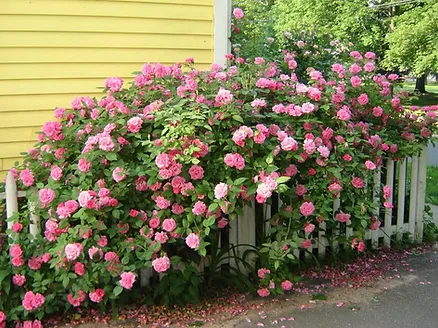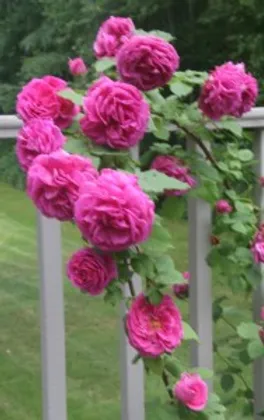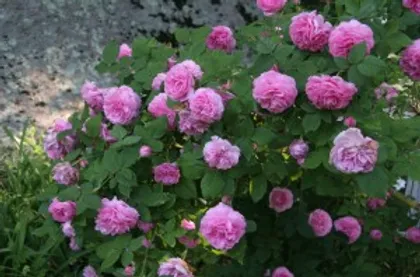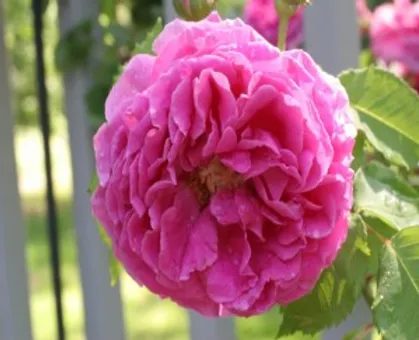
Rest assured that despite my leading title I am not trying to drive you to liquor, but rather want to interest you in a popular class of 19th century roses. Originating on the volcanic Île de Bourbon (now known as Réunion) in the Indian Ocean, these beauties started as the love children of damask and china roses planted in hedgerows in the early 1800s. Some of these hips were sent to the French royal gardener, who produced a seedling named ‘Rosier de l’Île de Bourbon’. Fragrant and blooming in flushes, a whole new class of roses was born.
Bourbons are intensely romantic and overwhelmingly fragrant. Draped over arbors or climbing up pillars, they will bring French charm to any garden and evoke a bygone era with a gentler pace of life, when there was time to smell the roses and revel in their sensual scent.

Many Bourbons can get quite large and require support such as fences or trellises. They are excellent candidates for pegging to the ground for maximum flower production. One of my absolute favorites, ‘Zéphirine Drouhin’ (pictured below) is a large, deliciously fragrant climber with the added benefit of being thornless! It is planted on the north side of my house and is almost never watered because my hosepipe doesn’t reach easily. Nonetheless, it rewards me for my horrible treatment with a spectacular display early in the season and then intermittently throughout the summer.
Many Bourbons are widely available from the usual sources and I know that they are appreciated by several CT rose society members like the Longs, who grow Mme. Isaac Pereire and Louise Odier with great success.
‘Mme. Issac Pereire’ (Above and right) ranks amongst the most fragrant roses in existence and produces very large, pinkish magenta flowers that start off cupped and reflex into quartered blooms with a button eye. Mature blossoms fade at the edges and create a two-tone effect. Bright pink ‘Louise Odier’ (See Below) can easily reach 6 or 7 feet and benefits from some support or training on an espalier against a wall. Deeply cupped and quartered blooms appear almost continuously and are rich in fragrance. ‘Mme. Ernest Calvat’ is the pale, bushier sport of ‘Mme. Isaac Pereire’. You can grow it as a pillar rose or prune it into a luxurious shrub that will produce fragrant blooms for cutting.
‘Boule de Neige’ produces clusters of blushpink buds on fairly upright canes that open to reveal creamy white blooms, with the occasional green eye in the center. If you are fond of striped roses, try growing ‘Honorine de Brabant’. This modest climber has pale pink blooms streaked with delicate shades of mauve. The silvery blush pink of ‘Souvenir de la Malmaison’ is almost unsurpassed, and blooms, produced in clusters, are sweetly scented and have a mass of quartered petals. Despite its large flowers, it is one of the smallest in this class at about 3-4 feet in height and spread, but also comes in a climbing form. Marci has told me how she still pines for her ‘Mme. Pierre Oger’ that had to be left behind when she moved to Windsor from her previous home. This sport of ‘La Reine Victoria’ has dainty blooms of shell pink that make this a delicate and refined looking shrub.
Before you rush out and buy a garden full of Bourbons, I feel that I ought to mention the small matter of disease. Of all the Bourbons I grow, ‘La Reine Victoria’ can attract a fungal spore a mile off and is the best indicator that it is time to spray! Not all Bourbons are this susceptible, but I suggest you plant them in areas with good air circulation, water and fertilize them well, and keep up a spray program.

We are not talking ‘Knock Outs’ here, but maybe not quite Hybrid Teas in terms of maintenance. I have found these roses to be quite hardy in my garden, but remember to plant them deeply and, if you live in a very cold microclimate, hill them up for the winter.
Old Garden Roses have a lot of beauty and variety to offer the modern garden. They are living history and a wonderful link to the great and ordinary folk who grew them: from Napoléon’s Joséphine at Malmaison to our great grandparents and their country gardens. I feel passionately that they should to be preserved for future generations to love and appreciate. On that note, let’s raise a glass and toast these old ladies! Long may they flourish!





























































